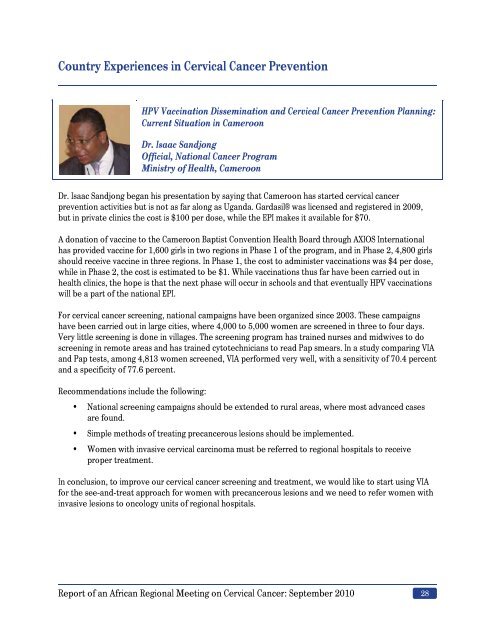Download file, English (1 MB PDF) - RHO
Download file, English (1 MB PDF) - RHO
Download file, English (1 MB PDF) - RHO
You also want an ePaper? Increase the reach of your titles
YUMPU automatically turns print PDFs into web optimized ePapers that Google loves.
Country Experiences in Cervical Cancer Prevention<br />
HPV Vaccination Dissemination and Cervical Cancer Prevention Planning:<br />
Current Situation in Cameroon<br />
Dr. Isaac Sandjong<br />
Official, National Cancer Program<br />
Ministry of Health, Cameroon<br />
Dr. Isaac Sandjong began his presentation by saying that Cameroon has started cervical cancer<br />
prevention activities but is not as far along as Uganda. Gardasil® was licensed and registered in 2009,<br />
but in private clinics the cost is $100 per dose, while the EPI makes it available for $70.<br />
A donation of vaccine to the Cameroon Baptist Convention Health Board through AXIOS International<br />
has provided vaccine for 1,600 girls in two regions in Phase 1 of the program, and in Phase 2, 4,800 girls<br />
should receive vaccine in three regions. In Phase 1, the cost to administer vaccinations was $4 per dose,<br />
while in Phase 2, the cost is estimated to be $1. While vaccinations thus far have been carried out in<br />
health clinics, the hope is that the next phase will occur in schools and that eventually HPV vaccinations<br />
will be a part of the national EPI.<br />
For cervical cancer screening, national campaigns have been organized since 2003. These campaigns<br />
have been carried out in large cities, where 4,000 to 5,000 women are screened in three to four days.<br />
Very little screening is done in villages. The screening program has trained nurses and midwives to do<br />
screening in remote areas and has trained cytotechnicians to read Pap smears. In a study comparing VIA<br />
and Pap tests, among 4,813 women screened, VIA performed very well, with a sensitivity of 70.4 percent<br />
and a specificity of 77.6 percent.<br />
Recommendations include the following:<br />
• National screening campaigns should be extended to rural areas, where most advanced cases<br />
are found.<br />
• Simple methods of treating precancerous lesions should be implemented.<br />
• Women with invasive cervical carcinoma must be referred to regional hospitals to receive<br />
proper treatment.<br />
In conclusion, to improve our cervical cancer screening and treatment, we would like to start using VIA<br />
for the see-and-treat approach for women with precancerous lesions and we need to refer women with<br />
invasive lesions to oncology units of regional hospitals.<br />
Report of an African Regional Meeting on Cervical Cancer: September 2010 28
















